When you’re travelling in a new destination, nothing beats having a local expert showing you where to find the best gravel riding. On a recent trip to Japan, Olly was fortunate enough to spend a couple of days in the beautiful city of Kyoto, arguably home to the finest gravel riding in the country. But where was the best riding located? How should the different trails be linked to together? What time of day should you aim to get to the bamboo forests if you want to have it yourself? To find out the answers to all these questions and more, he roped in local gravel connoisseur and 5* cycling guide Rob Colqui to show him around.
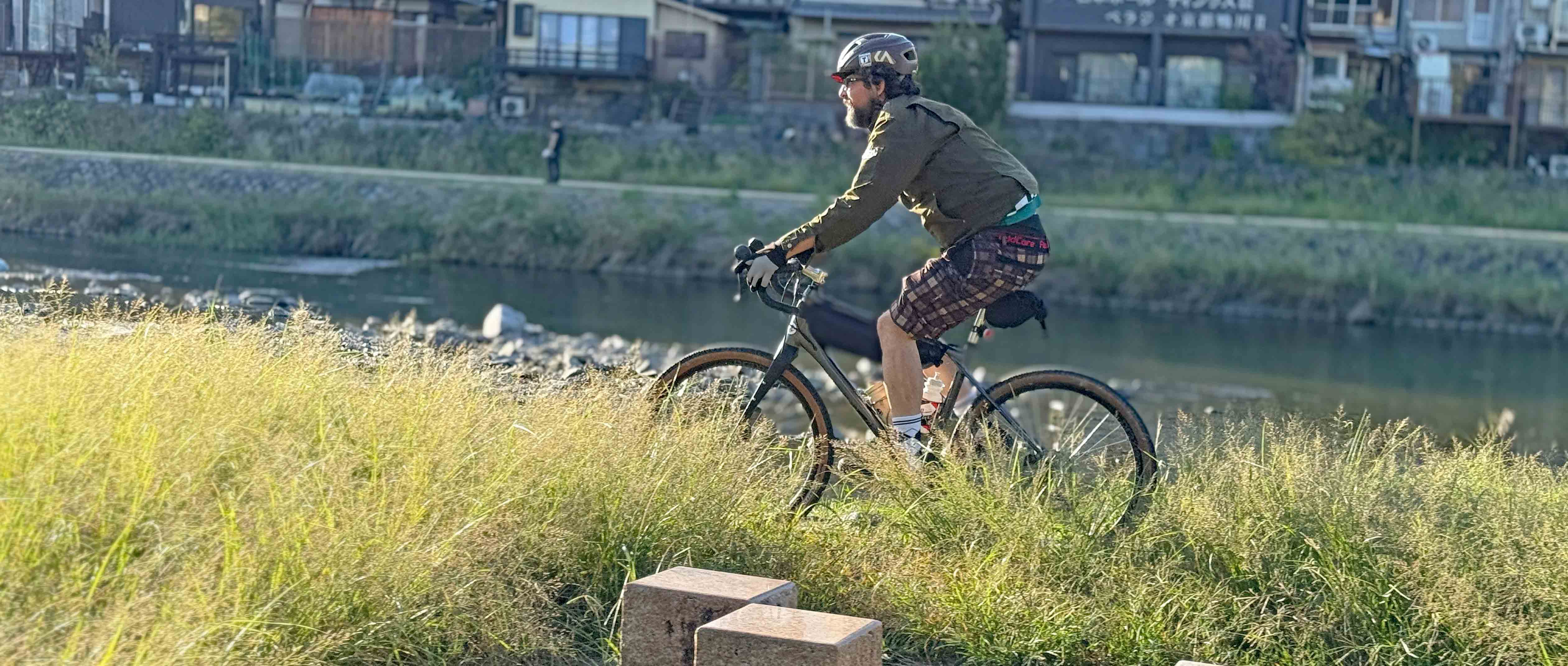
This photo probably sums up Rob Colqui’s attitude to gravel riding better than any other I took during the time we spent riding together. This was shot late afternoon as the sun was setting. We’d been out for nearly ten hours by this point and had ridden seemingly every scrap of gravel trails within a huge radius of the centre of Kyoto, but Rob still hadn’t quite had his fill. As we rode along a wide shared-use path on the banks of the River Kamo, he suddenly veered off, heading closer to the water. Initially I couldn’t figure out what he was doing, but then I realised there was a tiny scrap of sinuous gravelly singletrack which ran parallel to the main trail. It was barely possible to see and his route jinked and snaked it’s way around a variety of obstacles and hazards, but it gave him a few more precious minutes of gravel time and to him, that meant it was worth the risk.
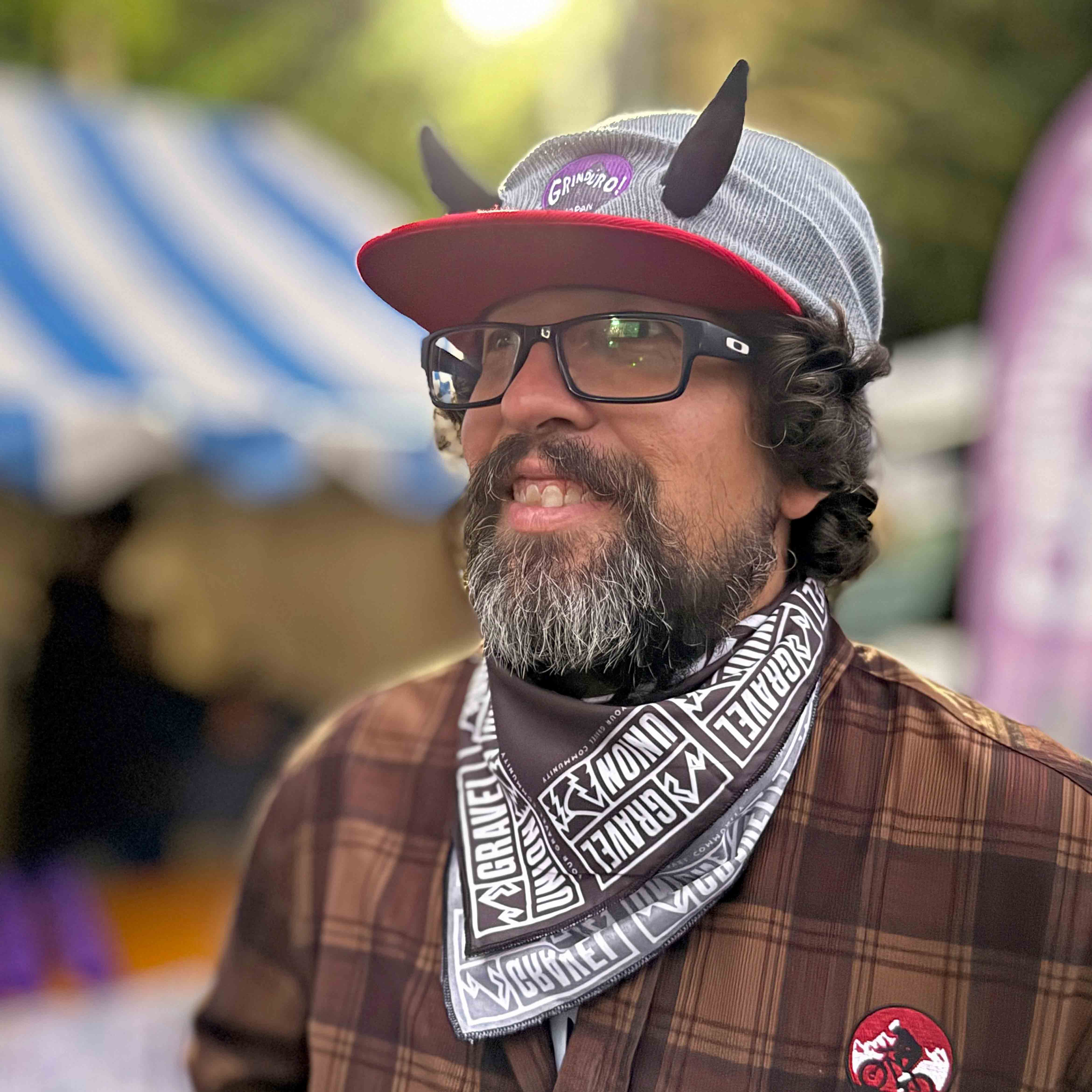
“Hi. I’m Rob and I’m a gravel hunter”. As introductions go, that one takes some beating. If anyone else said that to me I would probably have to bite my lip to avoid laughing, but when Rob says it, he’s not just trying to big himself up and it sounds genuine. Rob is the living embodiment of a gravel aficionado who seems to spend every waking minute searching for ever better gravel to ride around his adopted home city of Kyoto. He and I had already spent some time together earlier in my trip up in the mountains around Minakami, but we didn’t get to ride together there. Rob knew that I was keen to discover more about the gravel riding scene in different parts of Japan, so he invited me to join him on a long gravel loop ride which started in the very centre of Kyoto. Rob owns and runs Backcountry Japan, a cycling tour company and his bread-and-butter work is guiding cyclo-tourists around the sights of Kyoto. He is a qualified 5* city guide which means he knows every centimeter of Kyoto inside out. But his real love is gravel riding, so his plan is to grow his business to offer full day gravel riding tours around the city, as well as his existing range of shorter leisure tours in the city itself. He was going to give me a sneak peak of his planned gravel itinerary in return for some feedback and any suggestions for how he could make it better (TL;DR – He couldn’t – his gravel tour is AMAZING!)
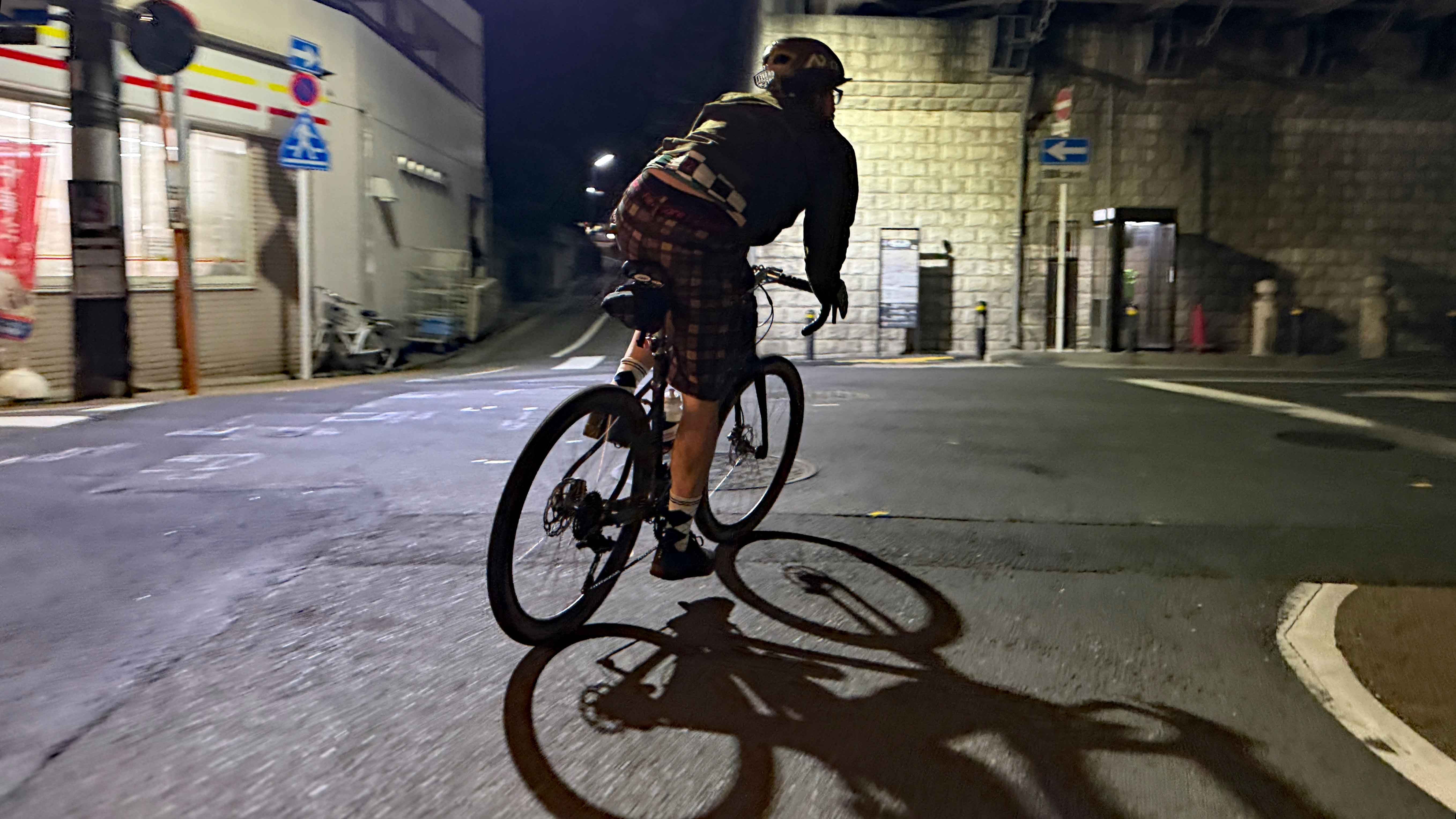
My alarm went off at 4.15 am, which is pretty early to start a gravel ride. Rob had asked me how early I would be willing to set off? “The benefit of going out earlier is that we should get to experience the bamboo forests before the other tourists get there”. That sold it to me, so we arranged to meet at 5am. Unfortunately, when I had been taking part in Grinduro Japan a few days before arriving into Kyoto, my beloved Exposure Joystick light had bounced out of its mounting bracket on my handlebars on a particularly fast and lumpy descent and had disappeared into the bushes somewhere. I still had my rear light, but it meant that the first part of our ride, when it was pitch dark, would be a little more entertaining than I had expected.

As I exited the front door of my hotel and clipped into my SPD pedals, I heard the distinctive sound of a bike computer bleep and a cyclist came to a stop right next to me. Rob had timed his arrival to perfection – both of us were a few minutes early for our meet-up, a habit engrained in our pysches during our respective tour guiding careers. Rob laughed when I told him the tale about my missing light. He had also had a lighting disaster as his own one hadn’t charged properly, so we were both going to be riding by brail! The route he had plotted took us initially south, heading for the Katsura River. We glided through completely disserted streets. Our route was a mix of tiny backstreets, hard-segregated cycle paths, urban alleyways and some shared use trails. Neon lights flickered overhead and we absorbed the sights, sounds and smells of a vast city, the majority of which was still sleeping soundly.
As we rode, Rob told me about his history. His was quite an amazing story – born to Peruvian and American parents and growing up in a Spanish-speaking household in a small Mormon town in Utah, USA, he developed a natural aptitude for languages. At 19, he left home to go on a Mormon mission to Panama where he further improved his linguistic skills and broadened his horizons from his small-town childhood. He studied teaching of foreign languages at college. During his time as a student, he signed up German lessons, but the class was cancelled due to lack of interest from other students. The only other subject that fitted with his schedule was Japanese, so he took it “almost by default”. He proved to be super capable and was subsequently invited by his professor to participate in a Japanese speech contest, where he won second place in his state (losing only to a fellow student who was born to Japanese parents…) His prize was the opportunity to study aboard in Japan for a summer and he fell completely in love with everything about the country.
In his youth in Utah, Rob learnt to ride horses as a way of earning some money herding sheep and cattle on nearby farms and he held a dream for while of becoming a cowboy. He missed the feeling of riding when he came to Japan, so bought a second-hand bike and used it as a proxy for a horse while he was living there. While working as a language teacher in a school in Japan, one of Rob’s pupils suddenly died after contracting meningitis and the shock of this affected him deeply. With his love of horse riding, he had long held dreams of riding across the Mongolian Steppe, but with the death of his pupil as the reminder that life can be brutally short, he signed up instead for a multi-day bike ride called the Mongolian Bike Challenge. Despite the huge physical and mental difficulties imposed by this event, Rob made it safely to the end and was from then on completely hooked on cycling. Fast forward to the Covid19 pandemic in early 2020 and Rob, disenchanted with teaching and finding himself with time on hands, started exploring cycling routes near where he lived and then taking small groups of tourists on guided trips. Eventually he moved out of teaching and into guiding full time. He currently splits his time running his own guided tours and working as a licensed guide for other local companies.

The initial part of our route had been pitch dark. While the urban portions had been lit by street lighting, as we turned off onto a gravel trail running alongside the Kamo River, the light faded to nothing and we ended up riding by feel rather than by vision. Fortunately, Rob’s trail knowledge was impressive and he had ridden the route often enough to know where the smoothest lines could be found. The fact that we were riding ‘primo’ gravel trails within 3 km of leaving the front door of my hotel was surprising enough, but to be riding it in the dark made the experience even more special. “Bet you didn’t think you’d be riding on gravel so close to the city, right?” said Rob, his voice tingling with obvious excitement. The amazing part wasn’t just that we were riding on gravel, but how good it was and just how much there was of it. It turned out that Kyoto historically had been incredibly prone to flooding, but based on advice from Dutch engineers, large levees were built alongside the rivers. These levees were constructed from aggregate which had a naturally gravelly surface. Perhaps also with some Dutch influence, local people started using the tops of the levees as improvised cycling routes which led eventually to the creation of a network of traffic-free urban trails, absolutely ideal for gravel riders looking for some early morning inspiration.
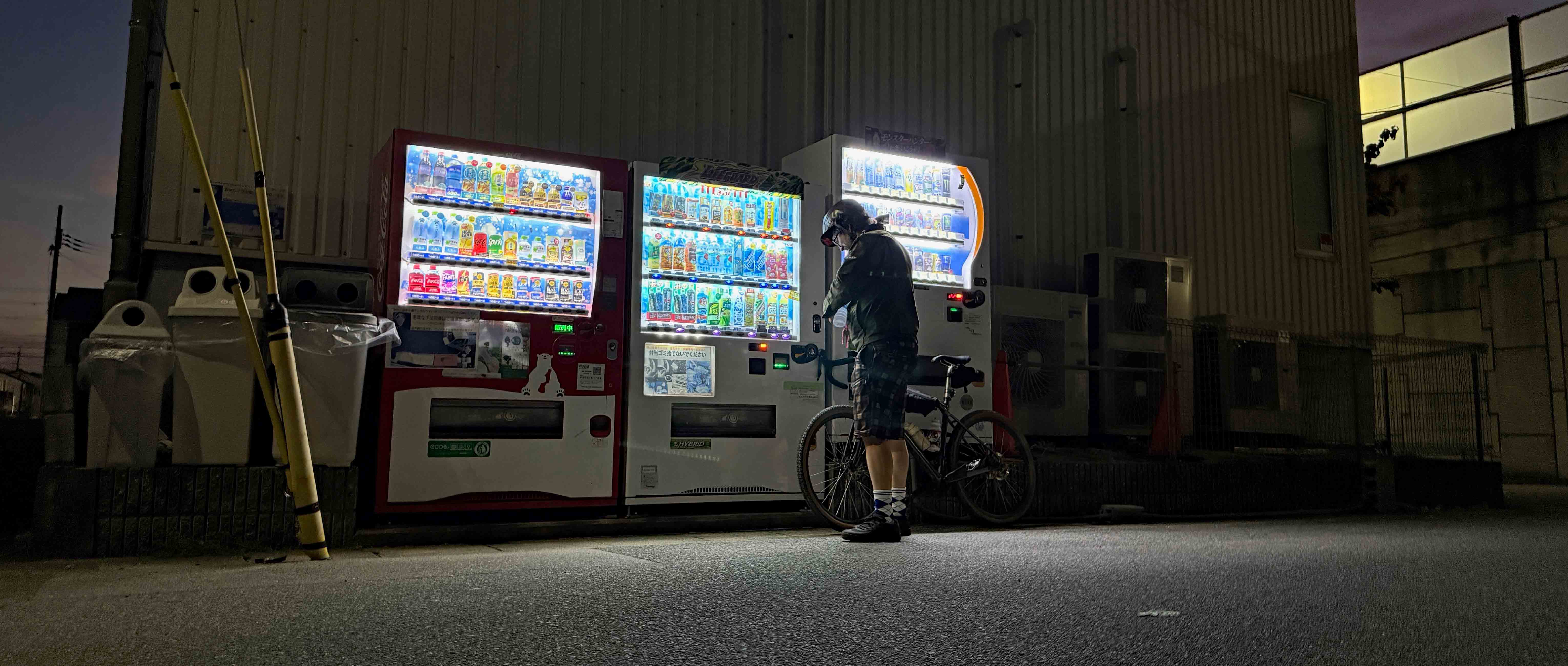
Before I travelled out to Japan, I had seen some amazing images of vending machines located in the middle of nowhere (even some powered by solar-charged batteries so that they could work without mains power in remote locations), but I assumed these were few and far between. It turned out that you can find them almost everywhere. As we flew along a section of pre-dawn gravel so smooth it could have been the Kyoto equivalent of strada bianche, I spotted some bright lights off to the right-hand side next to some anonymous looking industrial buildings. I suggested to Rob that we peel off and head down to where they were as they made such a great photo. “Would you like a bottle of Pocori Sweat?” asked Rob, slotting some coins into the machine. Fortunately, it tasted a lot better than it sounded!
Suitably refreshed, Rob led us away from the river and through the suburbs, heading for our first “star” destination of the ride – an area of bamboo forest enmeshed with a network of amazing woodland trails. Just in this one short section of urban riding, he somehow managed to include many of the archetypal sites of any visit to Japan – streets full of tiny houses with a micro-car parked outside, scraps of land between buildings being used to grow crops and a hillside cemetery with a view across high rise tower blocks to the Nishiyama Mountains in the distance. After a completely flat start, our route suddenly started to climb and I could tell by Rob’s body language that we were about to arrive somewhere special.
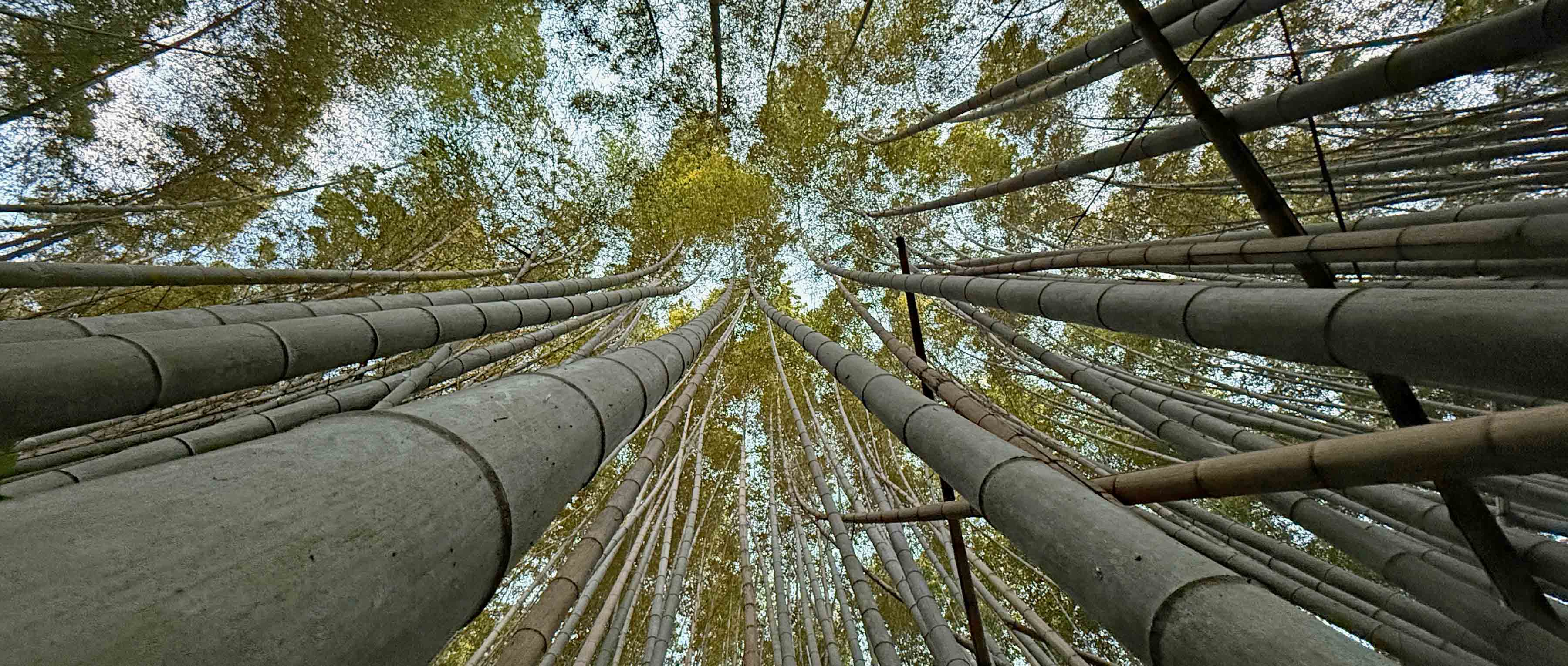
Japan is world famous for its bamboo forests, but many of them are either such super-star tourist attractions that they’re too busy to enjoyably ride through, or they are privately owned/managed and are off-limits for gravel riders. Fortunately, Rob knew of any area high up above the city which was accessible to us and which was full of surprisingly fun (and pretty challenging) riding.
The overall size of the bamboo forest was not vast, but it was covered with trails – some smooth and flowing, some steeper and more technical. Rob warned me to be slightly wary of riding over any broken bamboo lying on the trail as he said it could be lethally sharp and was well known for slicing open errant bike tyres. The bamboo trees themselves were amazing (and completely unlike anything I had experienced before) but it was the solitude that was most remarkable. We literally had the entire place to ourselves – Rob had definitely made the right call when he suggested the early start.

Back on paved roads again, we were still early enough that there was very little traffic about. We made a rapid descent back towards the river and just as I was starting to get used to riding through super-quiet back streets, Rob jinked around an anti-motorbike barrier and we found ourselves back in gravel heaven, riding along the banks of the Katsura River again. We made rapid progress along a gravel trail constructed on top of a levee. Either side of the us, the super fertile soil was being cultivated for a huge range of different crops. One of the things I loved most about Japan was the constant juxtaposition of things that you wouldn’t normally think fitted together – we were riding through the outskirts of a vast city, surrounded in all directions by infrastructure and buildings, yet slotted into every available space were areas of immaculately managed agricultural production. As the sun burst over the horizon, the landscape really popped with colour and despite the early hour, as we headed north along the banks of the river, the shared-use trail started to fill up with impressive numbers of elderly people out doing gentle exercise in the warm early morning air.
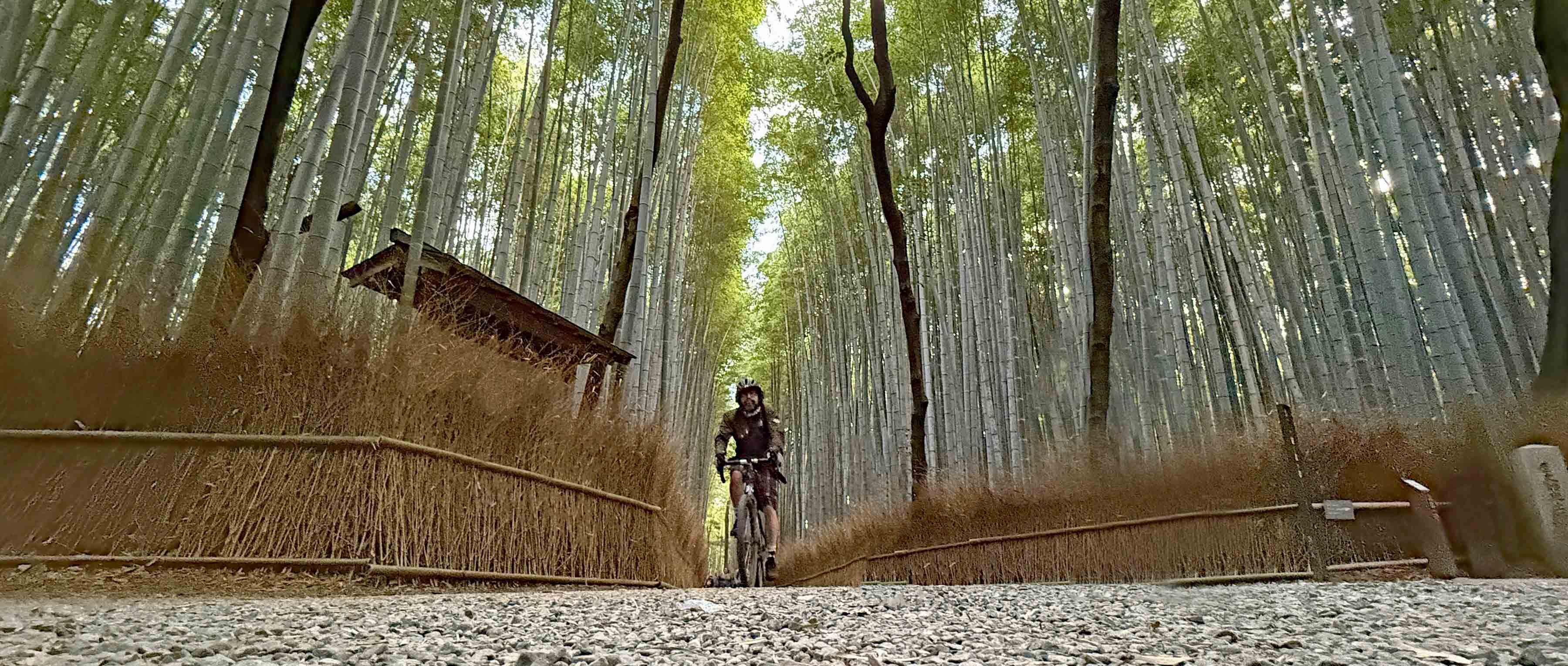
“I’ve bought other visitors to one or other of the bamboo forests before” said Rob as we headed towards the über-popular tourist attraction of Arashiyama Bamboo Forest “But you’re the first to do both in the same ride. I’m not going to tell you which is my favourite, but I’d be interested to know which you prefer.” As we neared the forest, Rob reached into a handy pocket and pulled out a small bell which he attached to his seat pack. “It’s to let bears know that we’re around” he said, “but it also works well for tourists.” It would be fair to say that the Arashiyama forest was stunning. Willowy bamboo shot upwards towards the heavens. What felt like manicured gravel trails ran through the centre of the forest, with environmentally-friendly fencing made from bamboo fronds in place to keep the tourists away from the bamboo itself. It was undeniably stunning, but it was also sobusy! Compared to our first forest which we had to ourselves, this time we were just part of an early morning throng of tourists all looking for the perfect Insta moment. We wound our way slowly through the crowds to arrive at “the” spot for capturing a photo. By some utter miracle, just as we got there a bin lorry trundled slowly through up the trail towards us, squeezing the tourists out of the way. I crouched down and fired off a few frames which ended up making Rob look as though he was alone. What you can’t see is that right behind me is a significant number of tourists all vying for my spot and literally seconds later, it would have been swamped again. “If we had been another hour or so later, you wouldn’t be able to move here and we certainly wouldn’t have been to ride through the forest as easily as we just did” said Rob, grinning.

“Have you ever heard of a ‘rindo’ road?” asked Rob as we climbed gently up through the stunning architecture of Kyoto’s old city. I shook my head. “It comes from two words, Rin, which translates to forest and Do, which means path or road. The term is used to cover a variety of decommissioned roads, mountainous roads, roads that are a mix of bad asphalt and gravel. They have a uniquely Japanese aesthetic, kind of mossy, lots of sticks, leaves and rocks. Sometimes they can be quite overgrown. Most car drivers will try and avoid using them.” If you had asked me for my definition of gravel riding heaven, it sounded like a rindo road was it and Rob had designed our route to include some of the finest rindo roads in the Kyoto area. Shortly after we exited the city, riding past one of the ubiquitous and beautiful red-painted torii gates (which are located close to Shinto shrines and which symbolically mark the transition from the mundane to the sacred) we turned off onto our first rindo road. The symbolism of this was not lost on me.
Our rindo road swooped majestically through broadleaf forest, autumnal sunshine bursting through the canopy and making my inner photographer fizz with excitement. Around every corner was another amazing view, a change in road surface, some different light conditions. It was by a factor of a million the best thing I’d ridden in Japan. I struggled to get my brain around the fact that if we had ridden a direct route, this would be less than 20 km from the front door of my hotel. The whole section was only around 5km in length, but it was absolutely stunning and just this one section alone made the long journey out to Japan from the UK worthwhile.
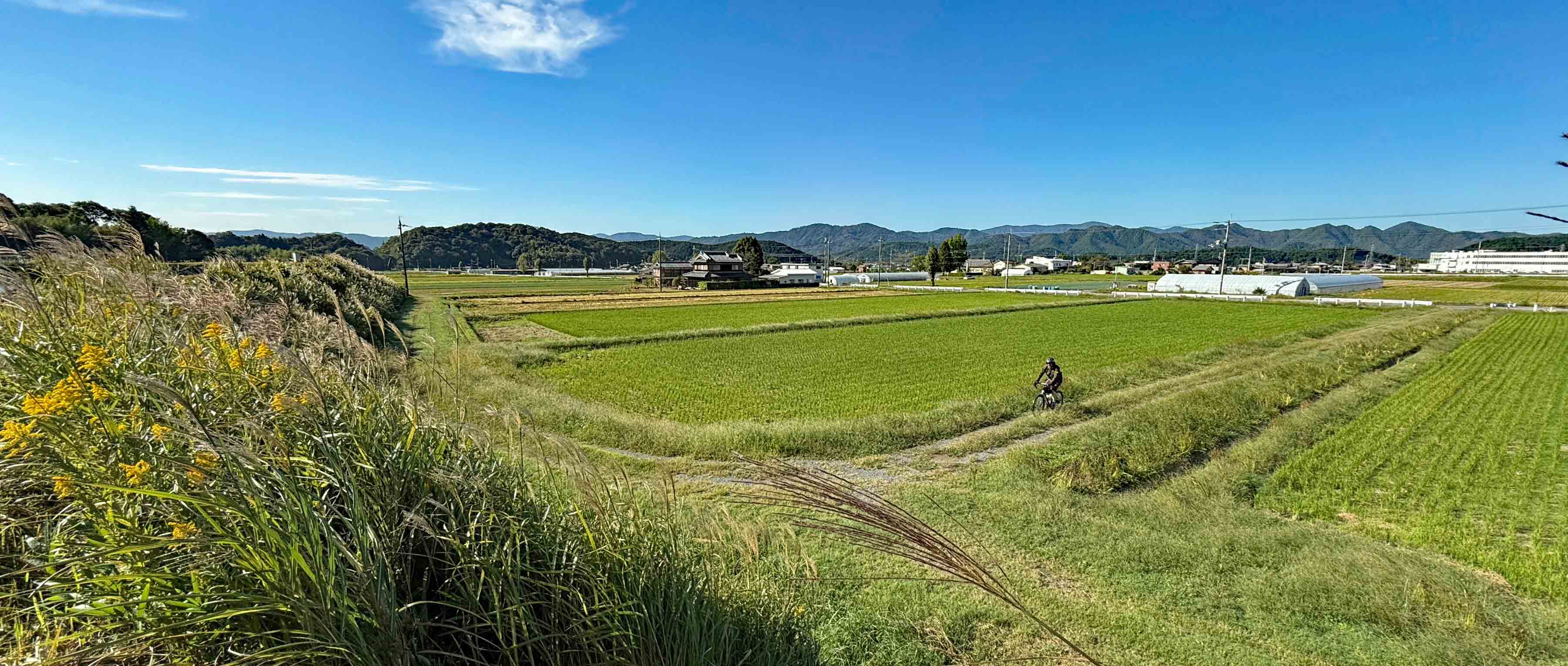
The whole of our route since leaving Kyoto had been through a series of hills and the rindo road in particular had been in places cut high up in a steep-sided valley, but as we reached the end of the first section, the topopgraphy changed. The city of Kameoka was located on a wide flat flood plain of the Oi River and the whole of the outskirts of the city seemed to be given over to rice production.
From Kameoka our route climbed in earnest. Initially we were on paved roads that Rob knew well, but as we reached the top of the first sustained section of climbing, he suggested we turned off the road to the left in search of some more gravel. By this time my stomach was properly growling. We had been riding for nearly 4.5 hours and having left way before the hotel started to serve breakfast and I had now depleted my inbuilt energy reserves. I had pockets full of cereal bars (which I was steadily munching my way through) but I was starting to get properly hungry and needed real food. Rob, it turned out, didn’t generally eat during rides, no matter how long they were. Luckily, he had appreciated that I would need to eat, so before we hit gravel again, we tried to hunt out a café or a shop. Unfortunately, as we were there in the shoulder season nothing was open. Fortunately, the gravel trails that we found were super fun to ride, so that took my mind of my stomach for a while! A super-fast and swoopy paved descent was followed by a delightful section riding gently along the bottom of a steep-sided river valley. As we reached a hairpin turn in the road, I spotted a campside off to left and figuring that there might be a café there, I suggested to Rob we turned off to investigate. There wasn’t a café, but there was a shop, albeit one that was bizarrely stocked. At the risk of making any nutritionists reading this roll their eyes in horror, breakfast ended but being a pre-packaged ice cream sandwhich and two large bags of crisps. Not perfect the ideal fuel for a long ride, but I felt significantly better afterwards.
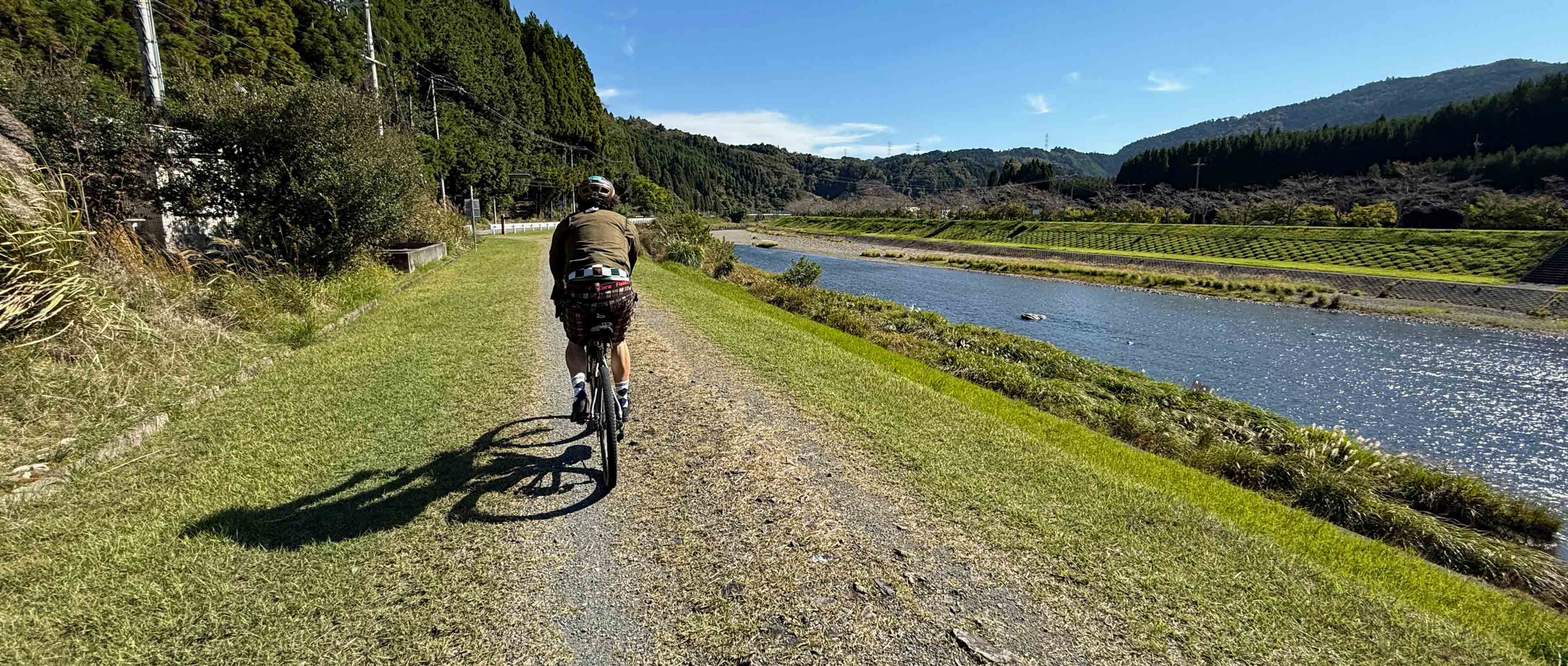
As we left the campsite, I knew from the route profile that we had a bit of a warm-up and then a long climb which would take us up to the highpoint of the ride at 750m. Initially we picked up a paved road, but we soon spotted a fantastic looking gravel road off to the right, running along the top of another levee. Relying on the gravel gods for safe passage, we swung off the road and onto gravel heaven (again). For the next thirty minutes we alternated between road and gravel trail, picking anything which looked fun and which was heading in roughly the right direction. While there are some quite strict access rules in places, these gravel access tracks seemed to be fair game and even though the roads were only lightly trafficked, it was a no-brainer as to which was more fun to ride.
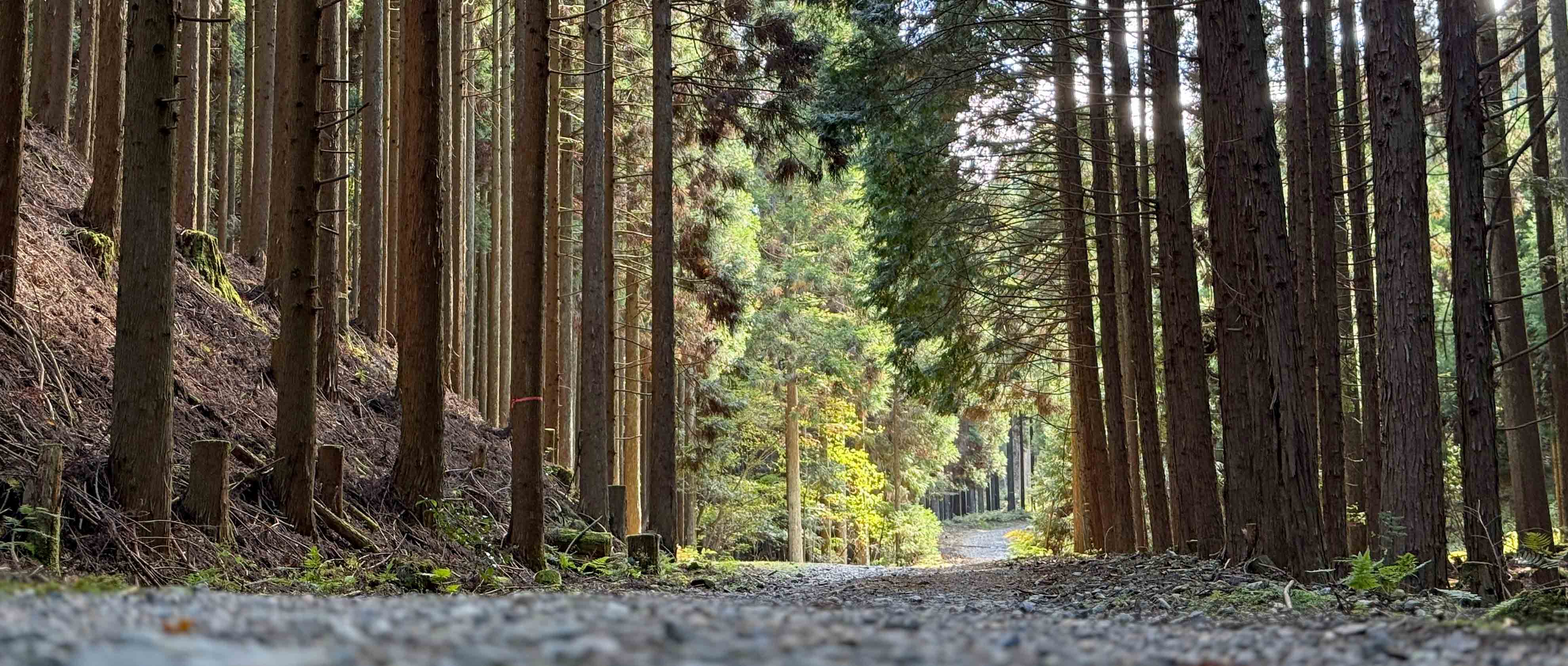
“The climb is on a rindo road and is pretty long” said Rob “I’ve not ridden it in this direction before, but I’ve descended on this route and I think you’ll enjoy it. We’ll just need to be a little wary of wildlife.” The climb was the ‘crux’ part of our route and gained 400 vertical metres in six kilometres. The surface and the gradient were absolutely perfect – it started off on smooth tarmac, albeit narrow – only just wide enough for one vehicle and as we climbed higher into the forest, the surface started to degrade. Initially there were some surface potholes, a few cracks, some loose stones, occasional tree branches but as we got higher the surface degraded and in some sections, I could feel my rear tyre scrabble for grip. The sun was beaming in a crystal-clear sky, birds were tweeting and all around there were the gentle sounds of a forest at peace. Unlike forest riding in Europe, there were no discernable jarring notes – no-one was working with a chainsaw or bombing past on a motorcross bike. Yet more gravelly heaven, Kyoto style.
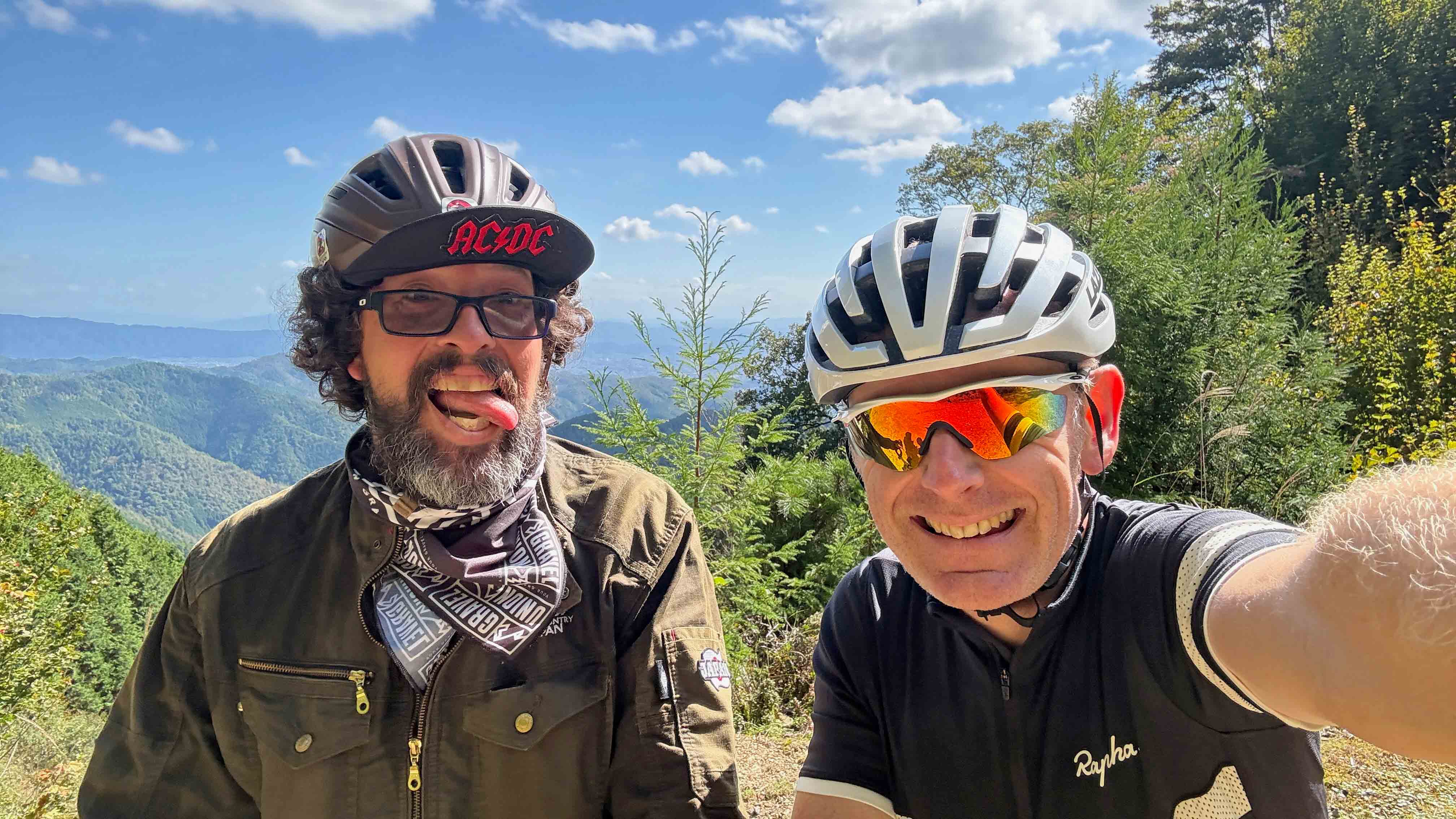
My mum always warned me to be wary of strange men lurking in the woods, but luckily, I knew this one pretty well by now. Plus, he was wearing a Gravel Union neckerchief, so he must be ok really? Once we had got our breath back at the highpoint of the ride, our route headed downhill. A stunning, sweeping rindo road led us down through the forest. I had to keep trying to remember there might be a bear around every corner and not just put my head down and blast, but the temptation was the great as the track was so perfect.
Just as my stomach was starting to rumble again, we rode passed a small café which Rob knew. They had a traditional Japanese dining room built on stilts above a beautiful babbling stream. Rob was in charge of ordering and we ended up with steaming bowls of soba noodles with woodland vegetables which was absolutely delicious.
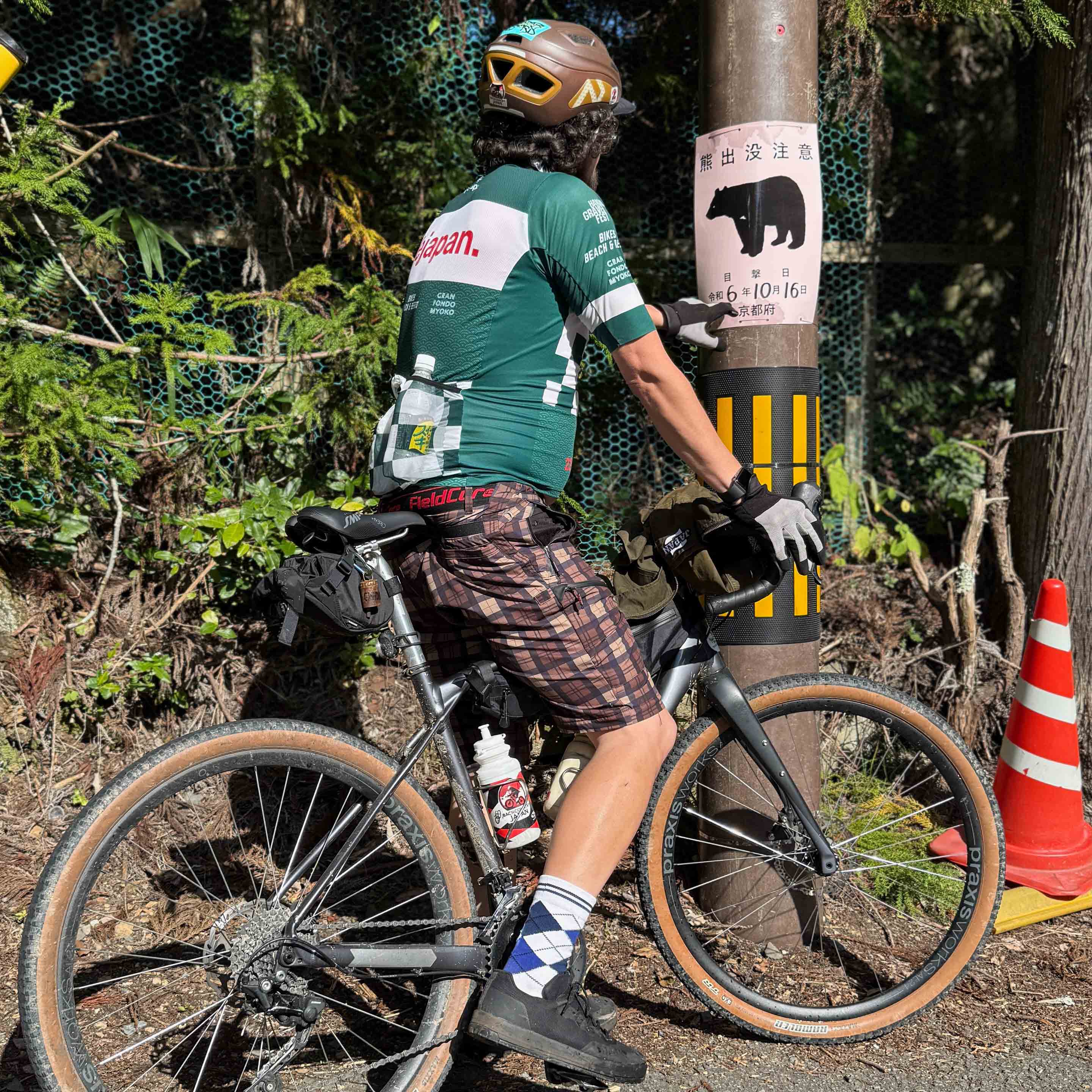
As is always the way, we had nearly 10 km of climbing to do after lunch, the first section of which was on the only busy section of road that we encountered all day. The road was pinned in the bottom of a heavily wooded steep sided valley and unlike the earlier part of our route, there were no handy rindo roads for us to use to avoid the traffic. Fortunately, we weren’t on there long and it was a very useful reminder of how amazing the rest of the route had been. As we reached the top of our final climb of the day, just off to the left of the road we spotted a notice on a lamppost with a very obvious bear logo drawn on it. Although we were heading back towards urbanville at this point, we were still surrounded by forest. Rob read and translated the sign and it warned that a large bear had been seen at this spot only a few days before we were there.
It reminded me to ask Rob about the provenance of his bear bell, attached to his saddle bag and gently jangling as we rode along. It turned out it had been constructed from an upcycled coffee tin bought from one of the ubiquitous Japanese vending machines, but then it had been given an appropriate wabi sabi aesthetic by Rob. He had also carefully added the Grinduro logo, imbuing it with yet more gravelly spirit.
As we descended out of the hills and back into Kyoto, Rob suggested we stop off for a quick visit to the world famous Kinkaku-ji temple. While the buildings and gardens were stunningly beautiful (and are a practically mandatory part of visiting Kyoto), I felt distinctly out of place, clad head to toe in cycling kit and clip clopping around in carbon-soled cycling shoes. I’m glad we saw the temple, but I wouldn’t go out of my way to visit again and it paled into insignificance on the list of spectacular things that I had witnessed during the day.
Rob had a few more tricks up his guiding sleeve, including riding some pristine (and apparently completely legal) woodland gravel trails through Kyoto’s Gyoen National Garden, including rolling right passed the Sento Imperial Palace (not something you could do in many other countries in the world).
“Do you fancy a beer to finish off the day nicely?” asked Rob. What kind of question was that, of course I do! Rob set course for the Kyoto Beer Lab, a micro-brewery located not far from the banks of the Kamo River, which had the serendipitous result that we had nearly 5 km of sun dappled riverside gravel trail to traverse, to help further develop our thirst! I’d never had coffee-infused IPA and while it might sound revolting, I can assure it was delicious and had my stomach not been rumbling again, I could have happily stayed for much longer.
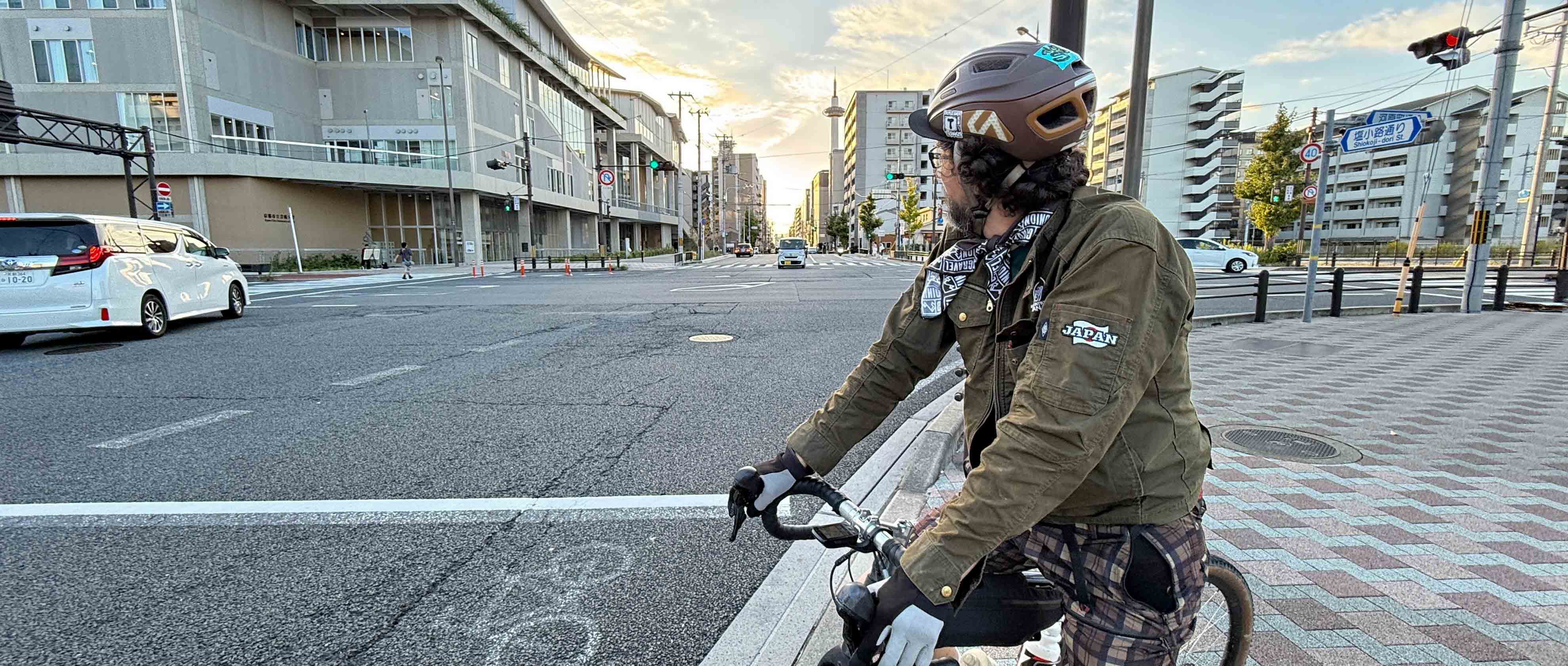
With the sun dropping in the sky, we realised it was time to go our sperate ways. I had that incredible sensation of having got our money’s worth out of the day. There’s something magical about setting off in the day, riding through the day and finishing just as darkness is about to return. Rob had showed me so many incredible sites that it genuinely felt like we had done three or four different rides rather than just one.
My experience of riding in Japan is incredibly limited and I can’t claim to be any great authority, but I can say without doubt is that the riding around Kyoto is mind blowingly good. For most Europeans, just the length of the journey to Japan might put you off, but if you ever are fortunate enough to be able to travel there, then I can’t recommend highly enough spending a day in the company of Kyoto’s Gravel Hunter.
You can find out more about Backcountry Japan at their Facebook page or give Rob a follow on Insta.